
Preface: I just want to warn potential readers that this is very long. It is also not really a narrative. It is essentially my notes from the conference. I hope that you can make some sense of it. I might eventually get around to translating it into a narrative of the day. Anyways, it was a very interesting day and I hope that you may get some information out of it.
One more thing, if you want to follow the day from beginning to end, then start at the bottom and work your way up.
10:00pm: Home after a long day. After this evening's lecture there was the official opening of the accompanying exhibition. Here's a few pictures.
The lights for the exhibition are being powered by a PV cell in Meyerson Plaza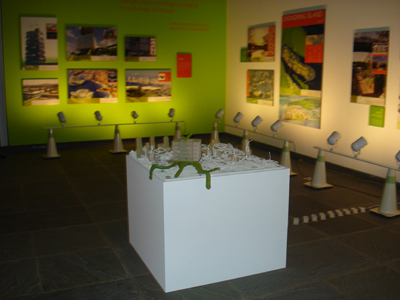


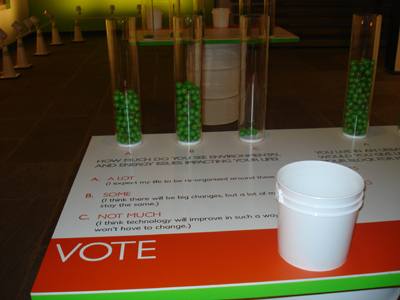

Neal Pierce Lecture: "The Century of the City: No Time to Lose"
The new book of the same name as the lecture emerged out of a month long series of conferences on the city, The Rockefeller Center Global Urban Summit. How will we accommodate the next 100 million Americans with our overburdened infrastructure? If urban population growth continues at its current rate, we will have to build a city for 1 million people every 5 days for the next 42 years. In many ways, the slums of the global south are like Jane Jacobs type urbanism in their incredible mix of uses. 70% of the architects are in the developed world, but 70% of the work is in the developing world.
Panel Discussion of Journalists: How do we get the message out?
IS: No revolution has ever been made without the assistance of the fourth estate.
AR: Human caused climate change is a symptom of something much larger, the coming of age of the human race. In 1830 there were 1 billion people in the world, now there are 1 billion teenagers. dotearth.blogs.nytimes.com
EK: The issue of "green" is still highly partisan. Drill, baby, drill sums it up. We have to make the problems understandable and tangible for people. Combine the macro and the micro.
NY: B2B, they're not focused on the consumer, but rather architects and designers. The design and construction industry is one of the few "essential industries."
WR: The trouble with messages is that they take their own course and are morphed by people. A degree of skepticism and irreverence is important. If grass on the roof is good, why is grass in your front yard so bad??? Why do we give awards to buildings that haven't been built yet? Would they give an Oscar to a movie that hasn't been made yet? Suddenly everyone's green, it is like the green fairy came at night and touched everybody. The American public is "changeable" as we saw earlier this week, so it is possible to institute some of the changes that we have been talking about all day.
IS: Has the media put too much emphasis on changing personal habits rather than government policy?
AR: What would an energy "moon shot" look like?... Spending on energy R&D has been decreasing since the 80's and is dwarfed by spending on health, space, genetic science, etc. Federal policy matters hugely and overwhelms what can be done on the personal level.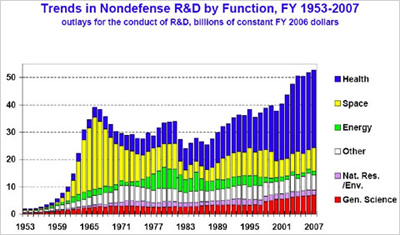
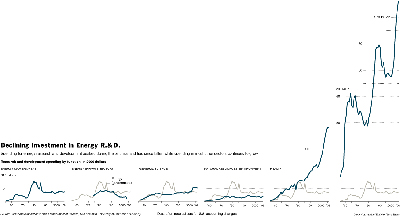
This graph shows gov't energy research spending at the far left in comparison to defense research spending at the far right. See the graphic bigger here.
IS: Does LEED certification mean anything? Or is it a marketing ploy?
NY: Greensource is currently building a database of 3 years worth of case studies about LEED buildings. I think that a standard is a good thing. Yes there are problems and people can take advantage of the system, but it is largely a good thing. It's not a be all and end all.
IS: Witold, as the resident skeptic, how much do you feel obliged to discuss a building's green credentials?
WR: I do try to go to buildings while they're in use rather than on press day. I'm puzzled why green buildings have to have so much glass. It seems counterintuitive. Why make a building that is all glass and then cover it in ceramic tubes (Piano's NYTimes building)? Why not just make the windows smaller? I was talking with Ricky Wurman today and he said that architecture today is all bling.
NY: I think that the oil problem today is different from the 70's in that the oil shortage in the 70's was a result of global politics. Today, it is absurd to not realize that the supply of oil is decreasing. The problem is completely different.
Up next is the evening lecture/panel discussion at 5:30. Neal Pierce will give a presentation on "The Century of the City: No Time to Lose" followed by a panel discussion moderated by Inga Saffron with panelists Elizabeth Kubany, Andrew Revkin, Witold Rybczynski, and Norbert Young, Jr. I'm not sure if I'll be blogging live from the lecture, but if not I'll post some thoughts either later tonight or tomorrow.
3:30pm Afternoon Session: New Urban Forms and Strategies
CW: University of Toronto--- Landscape in relationship to contemporary urban form. Panel will focus on the design of buildings and landscape in relation to urban form in the post-oil world.
JB: Michael Singer Studio--- An artist working at the scale of infrastructure and the urban fabric. A sculpture studio working on large scale infrastructure projects. Alterra Institute by Behnisch+Behnisch: they designed the sculpture gardens. A sculpture that is helping to clean water runoff. Public art proposal in Grand Rapids, MI that is a retaining wall that cleans water runoff from a parking lot. White paper on Infrastructure & Community for the Environmental Defense Fund. Gas cogeneration plant for TransGas at Green Hook in New York. Interconnection of infrastructure, community, and environmental action working together. 
Alterra Institute Garden by Michael Singer Studio et. al.
LH: William McDonough + Partners--- Fixated on how Hollywood portrays cultures, particularly our fears. Mike Judge's Idiocracy. The age of oil is not about a particular resource but about an attitude toward globalization. Biodiversity: global flows and local forms. "Economic globalization has hijacked culture, reducing it to a consumerist monoculture." Is McDonalds becoming our global identity? Gehry's and McDonald's attitude toward place is exactly the same, it's just prettier. 
The world's largest Costco in the movie Idiocracy
SK: KieranTimberlake--- Sidwell Friends School 60% better than a baseline building. That's good enough for LEED Platinum, but not good enough for the world. 107,000,000 existing housing units in the US in 2001. Only 28% of new housing units per year are architect designed. We currently teach for new design rather than retrofitting our legacy buildings. How do we transform the existing stock of buildings? How can architects "productize" housing? In Germany car manufacturers are required to take their cars back to recycle them at the end of their lifecycle. BMW now makes a profit on the deconstruction of their cars. We should be teaching deconstruction in architecture school. We need to get over the idea that architecture is permanent. We should think about our buildings the way that doctors think about their patients. KTA now monitors all of their buildings' performance. It is now a profit center for the firm.
The Loblolly House by KieranTimberlake
JW: University of Toronto--- MLK "the fierce urgency of now"... Obama campaign as an example of the mobilization of great force through small increments. Cultural practice can change much quicker than the physical city. How much energy would be saved if the government reinstituted the 55mph speed limit?
3:10pm Up next: New Urban Forms and Strategies... A breakout session with moderator Charles Waldheim and panelists Jason Bregman, Lance Hosey, Stephen Kieran, and respondent Jane Wolff.
2:00-3:00 Afternoon Plenary Session - Post Carbon Thinking:
AS: WorldChanging People change not because of bad news, but because they see a better alternative. Right now there are very few examples about things that are going right. We have to dramatically cut the amount of energy that it takes to do things. Smart infrastructure grids. Stormwater problems: combined system overflows results in poop in our rivers. Possible solution: large interconnected system of cisterns around cities. True cost taxation: increase cost of producing CO2... results in subsidizing of things that are good. Location efficient mortgages: more money if you live somewhere that you don't need a car. Shared goods services: car sharing, Seattle handbag sharing. Long haul transportation: We have no idea how to fix this yet! Political transparency: www.farmsubsidy.org Open Innovation: Sharing across borders - the Open Architecture Network from AFH. We need a deepened sense of time to see things we are doing today will affect the world in the future.
RSW: 19:20:21 and TED I'm highly unacademic and I know that most of you people don't know who I am, but that's OK because I don't know who any of you are either. My ignorance is terrific. I embrace my stupidity, because I'm also really curious. The space between things. From the curiosity, I fill up my ignorance. A year and a half ago I heard that more people live in cities than not, so now I want to know about cities. His current project is a really cool website that he's going through called 192021.org. The Earth should be called Water not Earth. Everything should be flipped. The UN map is a map of blood because that it where every conflict starts. We really have a world of cities, not of countries. There will be 19 urban observances, 19 conferences in the cities around the world, books on each, a TV series, etc. What we know now is good enough as an operative until we know differently. Understanding precedes action, so we need to understand cities before we can fix them.
JH: ESRI Geography in Action (GIS)... Helping the City of Doha to map their infrastructure. All of the city's information is all at different scales and different standards. We build generic software that you apply to the world's problems. GIS is changing everything. It allows you to extract information and make decisions.
1:55pm Coming up next is the afternoon plenary session on "post-carbon thinking" in which "thought leaders on post-carbon thinking will illustrate the future of design from mega-regions to pioneering product design." The moderator will be Alex Steffen with panelists James Higgins and Richard Saul Wurman.
Peter Head presentation: I'll try to make out as many snippets as I can over the din of people talking.
Looking to reduce carbon footprints to 1.5 hectares per person or less. Direct relationship between energy spent on transport and city density. Models for low-middle income countries: ecocities in China and Curitiba, Brazil. Winning strategies for the ecological age: 1)Use waste as a resource. 2)Diversify and cooperate. 3) Gather and use energy efficiently. 4)Optimize not maximize. 5) Use materials sparingly. 6) Clean up, not pollute. 7) Do not draw down resources. 8) Remain in balance with the biosphere. 9) Run on information. 10) Shop locally..... London Climate Change Action Plan as a model. Arup Sustainability Research Centres set up around the world, the first of which is in London. Working on setting them up in China, Australia, and Africa. Transport Infrastructure for the ecological age: 1) high speed rail connecting city centers and international airport to replace regional air travel for distances of 600 to 800km, 2) Zero emission mass transport in cities, electric or hydrogen powered cars, buses and goods vehicles, 3) Consolidation centers for freight delivery in center cities with green fleets. Mass transit requires much smaller surface area for roads that can be used for other things like public spaces. Energy Infrastructure for the ecological age: 1) Large scale renewable energy - wind, wave, tidal stream, hydro. 2) Decentralized... Urban agriculture - produce food in cities to reduce shipping. Rooftop food production also helps cool buildings. Eco-Suburbs: Dedicated bike lanes, mass transit, alternative energy, urban agriculture, increased density to increase social cohesion in neighborhoods. Not a believer in biofuels because of the footprint implications and the fact that they use food which is becoming it's own challenge. Integrate energy, water and waste systems to increase efficiency so that waste becomes energy. 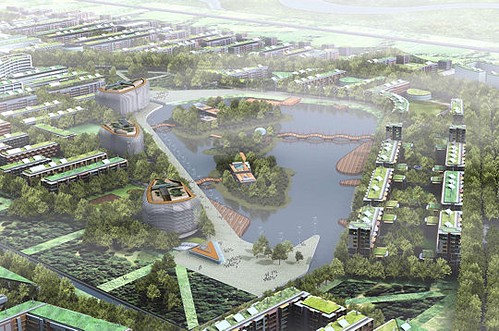
Dongtan Eco-City by Arup
12:56 They got the sound working shortly after Peter Head started. Unfortunately a lot of the people in the overflow room seem more interested in talking amongst themselves rather than actually listening to him.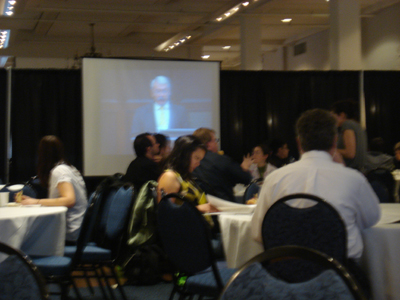
12:49 Next up is the lunch lecture which will feature Peter Head the Global Leader of Planning and Project Director of Eco-City Master Planning for Arup. He's currently being introduced by David Leatherbarrow whom I can see but not currently hear via simulcast in the overflow room.
11:00-12:30 Adaptation Strategies - Building and Landscape Design:
KVL: Framing questions for the discussion... How does the discipline of landscape architecture influence your work? How do the geological macro and microclimatic conditions of your region influence your work? How can issues of energy and water conservation, preservation and new social relationships be framed in aesthetic terms? How can architects use innovative new technologies in service of the principles of ecology and new dynamic cultural relationships? How can academia prepare the next generation of designers for this new world?
KVL: Public policy will be driven by what the public wants. UVA is hoping to create better professionals by focusing on cross-disciplinarity amongst architecture, landscape architecture, urban design, and other fields.
GG: arG Design Philippi Local Area Development Framework... An informal settlement upgrade project in Cape Town, South Africa... Anticipating a 3-degree temperature increase from climate change and an additional 3-degree increase from the urban heat island effect. Unemployment ranges from 58% to 45% in the study area. HIV/Aids deaths are very high. South Africa has 165 years remaining in coal reserves. They will rely almost solely on coal for energy after 2025. Will plant about 55,000 trees in the area. Using trees to lower the water table. Water thirsty trees, medicinal trees, flowering trees, etc. Detention ponds as productive wetlands and pocket parks. 80% waste recycled and only 20% to landfill.
Tsoga Environmental Centre by arG Design
JM: Rogers Marvel Architects Trying to do away with the Department of Architecture at Parsons and call it a Department of Design Science that blends architecture, landscape, etc. Cities behave like trees. Doubling and tripling the uses of architecture. 
Gowanus Green by Rogers Marvel
JP: Picciotto Arquitectos Patio/courtyard as climatic response in Mexican architecture. La Alhambra in Spain as a great bioclimatic architecture. Lack of long term design in Mexico City has resulted in major transportation problems. The urban pattern is like a "broken plate." 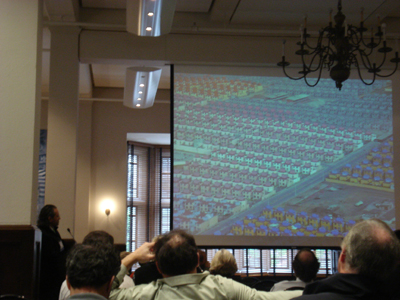
Jose Picciotto presenting an image of the type of awful rowhouse development currently being built in Mexico City
Morning Breakout Sessions: Adaptation Strategies (11:00-12:15) Five breakout sessions will focus on how urban places are adapting to environmental and energy problems.
I was planning on going to a different session, but since all of the rooms are so crowded I'm going to stay here in the back corner of the satellite room where I have power for my laptop. So the next session will be on Building and Landscape Design: For this session the moderator is Karen Van Lengen and the panelists are Gita Goven, Jonathan Marvel, Jose Picciotto, and the respondent is Frederick Steiner.
Opening Plenary (9:30-10:45):
EK: If we're going to avoid the unmanageable and manage the unavoidable, a lot will depend upon how we design the cities of the future and retrofit the cities of the past.
DO: My task is to summarize the problems in 10 minutes... Where is peak oil? Possibly 2010? No one really knows for sure, but we know that it will peak. Cities have always required concentrated energy. The megacity is an artifact of cheap oil. Coal and oil built the modern city as we understand it. US has no effective urban policy at the federal level. National debt will reach 231% of GDP by 2050. www.climateactionproject.com He has been working with the Obama transition team on the first 100 days of energy/environmental policy. Everything frozen on the planet is melting except Dick Cheney's heart. We need fast, easy, cheap, resilient solutions that don't simply move the problems around like nuclear energy. Energy return on investment is falling quickly. Urban policy will rise or fall based on transportation. We need other options: innercity rail and high-speed inter-urban rail. Value chains amplify the economic benefit...windmills have over 8000 pieces. Green/arts/theater district in Oberlin, Ohio. Oberlin College is trying to lead the redevelopment of downtown Oberlin by pushing green, "post carbon" development.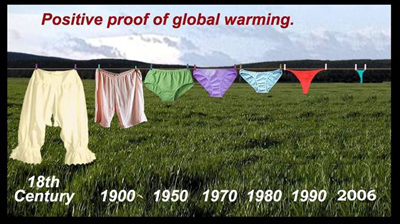
This image has been shown in a couple of different presentations already today.
AN: Will focus on the solution. Since he doesn't know the solution, it will be short, so he'll just tell stories. Transportation is the key. Focuses on climate policy in developing countries. Why is how and where we live vital to the future of climate policy? What is the nature of "globalness" in our globalized world? Cities are predatory beasts, they prey on the resources around them. Anyone can make up facts, but stories have meaning. A slightly disturbing story, a slightly inspiring story, and a story not yet told... Imagine if the world were one country... What sort of country would you see? It would be a very poor country. It would be a very divided country. It would be a very degraded country. It would be an insecure country. It would be a poorly governed country. It would be an unsafe country. The intergallactic travel advisory would advise against visiting earth. I want to argue that our world is a third world country. If we make policy like the world is Sweden, we will fail. We generally know how climate change happens. We know what can happen because of it, and we know that it is happening. The real question is about linking the environment and development. Most people that think about the environment don't think about cities. That's a problem. We can't have "sustainable development" without "climate stabilization". A conceptual evolution... Started as emissions problem, then it became an efficiency problem, then an equity problem, then a sustainability problem. Climate policy was predominately energy policy; Increasingly it will be more about water policy. Mitigation is primarily about energy. Adaptation is primarily about water (rising water, drying up water, water shortages). Dependence on oil is 200 years old, dependence on water has been around forever. Climate + Water + Cities. The deaths as a result of 60 years of war in Pakistan is less than the number of deaths in Delhi as a result about dirty urban water. $17.35 is what it takes to save one of those lives.
Questions/Comments:
If you were king and there was one thing that you could do to reduce the carbon impact of cities what would it be? DO: In the US it would be light rail and high-speed rail. A stringent transit policy. AN: Conservation... the largest untapped area of energy in the world is the energy we waste through inefficiency. DO: Cities need an urban vision.
How much can only be done through policy changes vs. design changes? AN: Policy needs to nudge. Designers need to take the nudge and run with it. Building is another key in addition to transportation. DO: Policy changes are certainly necessary. We now know how to design cities better than 50 years ago. Changes are difficult as a result of politics because of previous policy failures. He hopes that with the new administration the discussion of cities will start in policy. AN: Billion is the new million. If we can give $700B to Wall Street, perhaps $5B to save the world isn't too bad.
How do we sell "sustainable development" if it is more expensive than the status quo? DO: Do we have another hour? The limits of growth debate from the '70s needs to be revisited. We're not as rich as we think we are, we're just racking up national debt. The fastest way to find money is to take subsidies away from nuclear power, coal and oil. As a result, renewable energy becomes more competitive. Also look at the defense budget. There is money, but it requires political courage to get to it. AN: I don't think that there is additional cost. There are new winners and new losers. The new winners are individuals and the new losers are huge corporations/institutions that are already rich and powerful. The oil game is a 30 year game, the energy game is a 100 year game. Large changes come in small increments. The stone age didn't end because we ran out of stones. We still use all of the types of energy that have been invented in history, we just use them in a different mix.
What things around the world should be use as an example to implement? DO: There are really neat examples at all scales all over the world. BedZed in the UK. The best example would be a composite picture of creative things happening everywhere. AN: Curitiba is an obvious one. The Dutch idea of having bike sharing which is now being implemented other places like Paris. Zipcar and PhillyCarShare. Sustainability has become a legitimate political question.
9:24am The first panel session will frame the problem of how to address the challenge of reducing carbon emissions and unprecedented energy prices from scientific, historical, and global perspectives. The moderator is Elizabeth Kolbert and the panelists are Adil Najam and David Orr.
9:15am The main auditorium is apparently completely full as quite a few people are trickling back into the overflow room.
Judy Rodin, the President of the Rockefeller Foundation and former president of Penn, is introducing the conference. She's focusing on everyone's favorite word right now, "change", and mentioned the hope that our president-elect will focus on the issues effecting cities and urban issues today. She's saying that we need to focus on creating "green jobs" through creating mass/rapid transit.
UN-HABITAT estimates that within the next 30 years, 1/3 of people will live in squalor. Cities should not be seen as the problem, but rather the answer. The Rockefeller Foundation is trying to help the situation through the projects that they are funding throughout the world, with a particular focus on the emerging world. "Progress always starts with bold ideas."
9:00am Things are getting started about 15 minutes late. I'm one of 4 people in the overflow room watching Gary Hack do introductions.
As mentioned below, this conference marks the 50th anniversary of another conference that was held at Penn which included participants like Jane Jacobs, Louis Kahn, Kevin Lynch, Ian McHarg, Lewis Mumford, and I.M. Pei. At that point in time most of these people hadn't yet written their canonical texts and the hope is that the same greatness will emerge from this conference.
8:26am A few things before we get started... Supposedly the conference is also going to be covered live by several bloggers that were invited by the organizers. So be sure to check out their coverage too.
Treehugger
Grist
Planetizen
Wired
Urban Planning Research
Metropolis
Next American City
UPDATE: The live blog by the other writers is actually being hosted by the Next American City here.
8:08am Good morning. Today I'm attending a conference sponsored by the Penn Institute for Urban Research. I'll be posting updates throughout the day (or for as long as my battery lasts). I'll actually be watching the big sessions from a satellite room since I procrastinated on registering and the conference is actually sold out. I'll be able to get into small sessions space allowing. Right now its time for the breakfast buffet. The conference kicks off at 8:45 with welcoming remarks from former PennDesign Dean Gary Hack and Judith Rodin, the President of the Rockefeller Foundation.
Here's a little background on the conference:
This ground-breaking symposium has been organized to address the role of urban design in the face of one of the most profound and important challenges facing global society: the need to re-imagine and rethink how cities are designed and organized in a future without the plentiful and abundant oil upon which prosperous urban economies have been built.
The event marks the 50th Anniversary of the 1958 University of Pennsylvania/Rockefeller Foundation “Conference on Urban Design Criticism,” whose participants included Jane Jacobs, Louis Kahn, Kevin Lynch, Ian McHarg, Lewis Mumford, and I.M. Pei. That historic conference helped shape the new field of urban design in the 20th Century. Now, we hope you will participate in this critical exploration of new directions for 21st Century urban design.
The program speaks to the depth and diversity of the challenge with sessions on innovations in the way cities are conceived, adapted, designed, developed, and managed in a post-carbon world. The conference will conclude with a manifesto on educating the next generation of urban designers and how best to equip them for the road ahead.
An accompanying exhibition showcases innovative ideas, projects, initiatives, and policies from around the world that seek to reduce emissions by changing the way we inhabit cities. Documenting the rise in oil dependency, changing development patterns, and demographic trends, the exhibition threads prescient theories and artifacts surrounding the 1958 conference with contemporary challenges of the urban design profession.



4 Comments
Phil, I wish I could be there. great job so far!
Now I have to get back to my job burning oil and killing trees.
WOW! I'm exhausted and energized just by reading this, let alone being there! Thanks for the summary Phillip. Lots of idea nuggets in there.
Ugh--they still haven't changed those god awful floors in the Lower Gallery in Meyerson? Where does all that money go?
Thanks Phil for the great content/info heavy read.
Did you see this response to the symposium
Re-Imagining Cities: The Aesthetics Issue
http://www.metropolismag.com/pov/?p=2746#more-2746
Block this user
Are you sure you want to block this user and hide all related comments throughout the site?
Archinect
This is your first comment on Archinect. Your comment will be visible once approved.